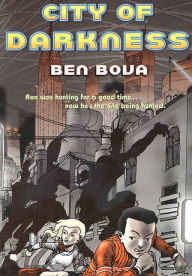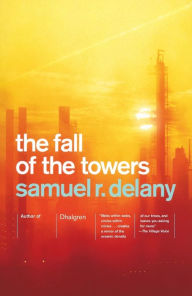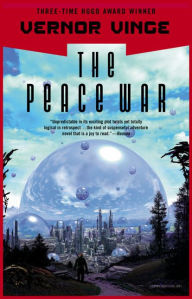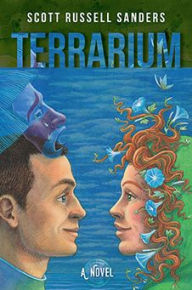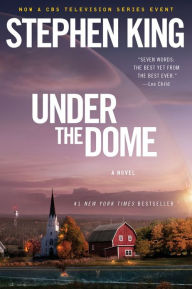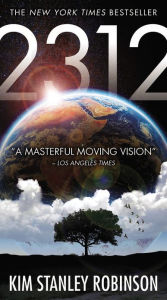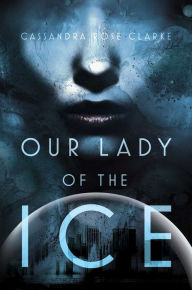11 Books About Domed Cities
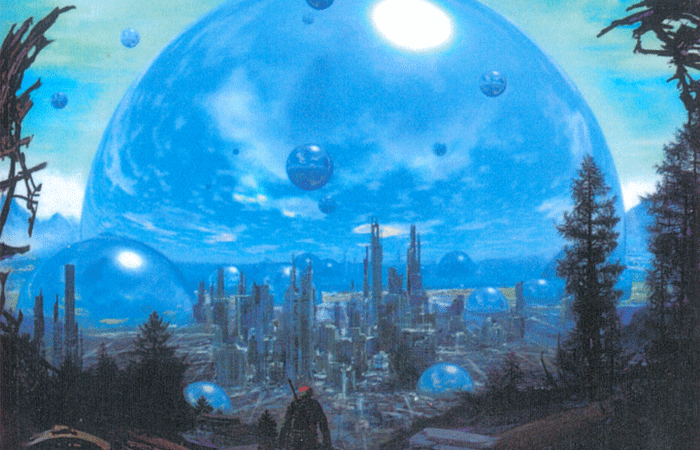 Domed cities have been a thing in science fiction since the very beginning, a salient metaphor made almost inescapable by its obviousness: inside, outside; same, same, not the same. The domed city is such a striking image, an enclosure of humanity out there on the Martian plains, or on a ravaged, post-apocalyptic Earth, or glinting in space in the orbit of a distant star. Its utility as a visual is probably why the concept appears more often in films—I can think of just oodles, without even straining—but the metaphorical implications are also too good for a novelist to pass up. The domed city encloses culture behind a technological barrier, and who it keeps in—and out—can be the engine for conflict. It traps society in a snowglobe, and when the writer shakes it, it snows, and snows hard.
Domed cities have been a thing in science fiction since the very beginning, a salient metaphor made almost inescapable by its obviousness: inside, outside; same, same, not the same. The domed city is such a striking image, an enclosure of humanity out there on the Martian plains, or on a ravaged, post-apocalyptic Earth, or glinting in space in the orbit of a distant star. Its utility as a visual is probably why the concept appears more often in films—I can think of just oodles, without even straining—but the metaphorical implications are also too good for a novelist to pass up. The domed city encloses culture behind a technological barrier, and who it keeps in—and out—can be the engine for conflict. It traps society in a snowglobe, and when the writer shakes it, it snows, and snows hard.
City of Darkness
City of Darkness
By Ben Bova
In Stock Online
eBook $14.99
City of Darkness, by Ben Bova
Bova’s Manhattan Dome is a dumping ground for undesirables, and visited in the summer months as a kind of slumming tourism by people from the vast suburban Tracts that surround the city. A Tract kid runs off to Manhattan Dome, gets mugged, and then can’t leave before the dome closes for the winter, locking him in. There are a number of books from about this time set in a domed New York (most of them out of print) that use the down-at-heel NYC of the ’70s as a cautionary tale, this most American of cities ravaged. Set against current gentrified New York, with its cheery, neon Times Square, these novels now feel stunningly anachronistic.
City of Darkness, by Ben Bova
Bova’s Manhattan Dome is a dumping ground for undesirables, and visited in the summer months as a kind of slumming tourism by people from the vast suburban Tracts that surround the city. A Tract kid runs off to Manhattan Dome, gets mugged, and then can’t leave before the dome closes for the winter, locking him in. There are a number of books from about this time set in a domed New York (most of them out of print) that use the down-at-heel NYC of the ’70s as a cautionary tale, this most American of cities ravaged. Set against current gentrified New York, with its cheery, neon Times Square, these novels now feel stunningly anachronistic.
The Fall of the Towers
The Fall of the Towers
In Stock Online
Paperback $22.00
The Fall of the Towers, by Samuel R. Delaney
Alarmingly, omnibus edition The Fall of the Towers, which collects three of Delaney’s very early novels, was published well before 9/11. Though Delaney never explicitly says so, the two domed cities of Toron and Telphar are obviously far-future, post-apocalyptic NYCs. One is an irradiated warning, and the other unstable and besieged. The Fall of the Towers is very, very early Delaney, and lacks the earmarks of his science fictional style, more a curiosity than required reading.
The Fall of the Towers, by Samuel R. Delaney
Alarmingly, omnibus edition The Fall of the Towers, which collects three of Delaney’s very early novels, was published well before 9/11. Though Delaney never explicitly says so, the two domed cities of Toron and Telphar are obviously far-future, post-apocalyptic NYCs. One is an irradiated warning, and the other unstable and besieged. The Fall of the Towers is very, very early Delaney, and lacks the earmarks of his science fictional style, more a curiosity than required reading.
Neuromancer
Neuromancer
Paperback $8.99
Neuromancer, by William Gibson
The quite famous opening line of Neuromancer, the Hugo and Nebula award-winning novel that begins the Sprawl trilogy, is, “The sky above the port was the color of television, tuned to a dead channel.” Gibson’s seminal cyberpunk novel takes place within BAMA—the Boston-Atlanta Metropolitan Axis—a dense urban landscape that is just 20 minutes into the future. That sky above the port is quite literally tuned to a dead channel: the inside of interlocking geodesic domes that covers the Eastern seaboard. There’s a lot going in Neuromancer, but the fundamental inhumanity of human-built landscapes, from cities to cyberspace, is a running theme, and the weatherless decay of BAMA exemplifies this.
Neuromancer, by William Gibson
The quite famous opening line of Neuromancer, the Hugo and Nebula award-winning novel that begins the Sprawl trilogy, is, “The sky above the port was the color of television, tuned to a dead channel.” Gibson’s seminal cyberpunk novel takes place within BAMA—the Boston-Atlanta Metropolitan Axis—a dense urban landscape that is just 20 minutes into the future. That sky above the port is quite literally tuned to a dead channel: the inside of interlocking geodesic domes that covers the Eastern seaboard. There’s a lot going in Neuromancer, but the fundamental inhumanity of human-built landscapes, from cities to cyberspace, is a running theme, and the weatherless decay of BAMA exemplifies this.
The Peace War
The Peace War
By Vernor Vinge
In Stock Online
Paperback $17.99
The Peace War, by Vernor Vinge
Fifty years before the events in Vinge’s Hugo-nominated novel, scientists developed a technology called the Bobbler, which creates an impenetrable force field bubble around anything from an individual to whole cities. In true dystopian fashion, the tech was turned into a weapon, encasing anyone who disagreed with the Peace Authority (ironic name alert). Presumably, they then run out of air and die. The Peace Authority subsequently banned most governments and all technological development. While a bobble-encircled city isn’t precisely a domed city, I think it’s interesting that the dome or bubble functions much the same way: it separates us from them, and works as a tool of social control and authoritarianism.
The Peace War, by Vernor Vinge
Fifty years before the events in Vinge’s Hugo-nominated novel, scientists developed a technology called the Bobbler, which creates an impenetrable force field bubble around anything from an individual to whole cities. In true dystopian fashion, the tech was turned into a weapon, encasing anyone who disagreed with the Peace Authority (ironic name alert). Presumably, they then run out of air and die. The Peace Authority subsequently banned most governments and all technological development. While a bobble-encircled city isn’t precisely a domed city, I think it’s interesting that the dome or bubble functions much the same way: it separates us from them, and works as a tool of social control and authoritarianism.
Terrarium
Terrarium
In Stock Online
Paperback $14.00
Terrarium, by Scott Russell Sanders
Sanders’s 1985 novel details a more classic dystopia: humanity enclosed in a network of domed cities, afloat on the oceans, due to extreme global pollution. There is large-scale social engineering, on the par of Brave New World, which not only dictates procreation, but also instills social fears of the outside, here called “the wild.” Teeg Passio is a “wildgoer,” one of those allowed to exit the domes to perform necessary maintenance. When she meets Phoenix Marshall, dome-bound resident of the floating Oregon City, she shakes up his ideas and his place in the world. Sanders is primarily an essayist, and Terrarium is a fictional outgrowth of his ideas about society. The image of the dome is a barrier between humanity and its natural state, a technological impediment between humanity and nature.
Terrarium, by Scott Russell Sanders
Sanders’s 1985 novel details a more classic dystopia: humanity enclosed in a network of domed cities, afloat on the oceans, due to extreme global pollution. There is large-scale social engineering, on the par of Brave New World, which not only dictates procreation, but also instills social fears of the outside, here called “the wild.” Teeg Passio is a “wildgoer,” one of those allowed to exit the domes to perform necessary maintenance. When she meets Phoenix Marshall, dome-bound resident of the floating Oregon City, she shakes up his ideas and his place in the world. Sanders is primarily an essayist, and Terrarium is a fictional outgrowth of his ideas about society. The image of the dome is a barrier between humanity and its natural state, a technological impediment between humanity and nature.
Perdido Street Station (New Crobuzon Series #1)
Perdido Street Station (New Crobuzon Series #1)
In Stock Online
Paperback $21.00
Perdido Street Station, by China Miéville
More than any science fiction writer going today, China Miéville loves to write him some cities. Perdido Street Station contains one of the best of them: New Crobuzon. Though New Crobuzon itself isn’t domed, it contains a domed city within it: the Glasshouse. Glasshouse is home to the cactacae, cactus people who are one of the myriad of non-humans who make up New Crobuzon. The Glasshouse was built as a form of social control, the cactacae leaders demanding autonomy from the larger city government, and then enclosing their numbers inside the dome not just because of idealistic notions of self-government, but partially to concentrate and control the cactus population. As part of the plot to track down some terrifying junkie insects, our bug hunters have to scale the Glasshouse and find the slake-moth’s lair within. The domed city-within-a-city of Glasshouse is like everything in New Crobuzon: dense, complicated, grimed with living, vibrant.
Perdido Street Station, by China Miéville
More than any science fiction writer going today, China Miéville loves to write him some cities. Perdido Street Station contains one of the best of them: New Crobuzon. Though New Crobuzon itself isn’t domed, it contains a domed city within it: the Glasshouse. Glasshouse is home to the cactacae, cactus people who are one of the myriad of non-humans who make up New Crobuzon. The Glasshouse was built as a form of social control, the cactacae leaders demanding autonomy from the larger city government, and then enclosing their numbers inside the dome not just because of idealistic notions of self-government, but partially to concentrate and control the cactus population. As part of the plot to track down some terrifying junkie insects, our bug hunters have to scale the Glasshouse and find the slake-moth’s lair within. The domed city-within-a-city of Glasshouse is like everything in New Crobuzon: dense, complicated, grimed with living, vibrant.
Under the Dome
Under the Dome
By Stephen King
Paperback $19.99
Under The Dome, by Stephen King
King has long found the ugly underbelly of otherwise wholesome-seeming small town middle America. Normal folk like you and me bury our pets on the wrong side of the graveyard, or are bullied viciously, or buy the wrong car, and then are slowly, irrevocably driven to make bad decisions for, if not good, then completely understandable reasons. King’s stories are scary precisely because his characters tend to make choices based on fear. Under the Dome is right in this vein: an invisible dome drops over the town of Chester’s Mill. The leadership, faced with this crisis, devolves rapidly into corruption and graft. This dome is different from many on this list, in that it was imposed on a city, not built, and for completely inexplicable reasons. However, the common themes are all there: Chester’s Mill is clearly both an environmental and political microcosm, an allegory of the time right after 9/11.
Under The Dome, by Stephen King
King has long found the ugly underbelly of otherwise wholesome-seeming small town middle America. Normal folk like you and me bury our pets on the wrong side of the graveyard, or are bullied viciously, or buy the wrong car, and then are slowly, irrevocably driven to make bad decisions for, if not good, then completely understandable reasons. King’s stories are scary precisely because his characters tend to make choices based on fear. Under the Dome is right in this vein: an invisible dome drops over the town of Chester’s Mill. The leadership, faced with this crisis, devolves rapidly into corruption and graft. This dome is different from many on this list, in that it was imposed on a city, not built, and for completely inexplicable reasons. However, the common themes are all there: Chester’s Mill is clearly both an environmental and political microcosm, an allegory of the time right after 9/11.
Pure
Pure
In Stock Online
Paperback $24.99
Pure, by Juilianna Baggott
In Baggott’s post-apocalyptic tale, after the Detonations, people living outside the Dome became fused to whatever was at hand: doll heads, the engines of cars, the earth itself. There’s some horrific imagery here, if you’re into this sort of thing: a harshly physical horror. They are “wretches,” seen as less than human. Inside the dome are “pures,” one-percenters untouched by the environmental and social destruction. The plot concerns Pressia, a wretch who, at 16, is conscripted into a brutal militia; and Partridge, a young man who is the son of one of the most important people in the Dome. Their trajectories point towards one another: Pressia straining for the shimmering perfection she sees in the Dome, and Partridge seeking escape from the emotional sterility of his life. What they each find on the other side of the glass is not what they’d hoped for.
Pure, by Juilianna Baggott
In Baggott’s post-apocalyptic tale, after the Detonations, people living outside the Dome became fused to whatever was at hand: doll heads, the engines of cars, the earth itself. There’s some horrific imagery here, if you’re into this sort of thing: a harshly physical horror. They are “wretches,” seen as less than human. Inside the dome are “pures,” one-percenters untouched by the environmental and social destruction. The plot concerns Pressia, a wretch who, at 16, is conscripted into a brutal militia; and Partridge, a young man who is the son of one of the most important people in the Dome. Their trajectories point towards one another: Pressia straining for the shimmering perfection she sees in the Dome, and Partridge seeking escape from the emotional sterility of his life. What they each find on the other side of the glass is not what they’d hoped for.
2312
2312
Paperback $10.00
2312, by Kim Stanley Robinson
Kim Stanley Robinson’s Hugo- and Nebula-winning space opera begins with a murder mystery of sorts: who killed the dome city on Mercury? The domed city of Terminator runs on tracks all around the planet, pushed by the expansion and contraction of its rails as Mercury turns through its harsh diurnal cycle. The tracks are broken by meteorites, and the city stops, to be engulfed by the molten Mercurial day. Robinson’s novels often detail, with really, really good hard science, how our technologically created environments influence both society and biology. The sections detailing the native Mercurial art, the Sunwalkers keeping just ahead of the lethal Mercury day, walking outside the domed city, are hauntingly beautiful.
2312, by Kim Stanley Robinson
Kim Stanley Robinson’s Hugo- and Nebula-winning space opera begins with a murder mystery of sorts: who killed the dome city on Mercury? The domed city of Terminator runs on tracks all around the planet, pushed by the expansion and contraction of its rails as Mercury turns through its harsh diurnal cycle. The tracks are broken by meteorites, and the city stops, to be engulfed by the molten Mercurial day. Robinson’s novels often detail, with really, really good hard science, how our technologically created environments influence both society and biology. The sections detailing the native Mercurial art, the Sunwalkers keeping just ahead of the lethal Mercury day, walking outside the domed city, are hauntingly beautiful.
Ancillary Sword (Imperial Radch Series #2)
Ancillary Sword (Imperial Radch Series #2)
By Ann Leckie
In Stock Online
Paperback $17.99
Ancillary Sword, by Ann Leckie
There’s a cold civil war going on in Radch space, and ship captain (and former ship herself) Breq is ordered to Athoek Station. Athoek Station orbits around a planet of the same name, built by the conquering Radch to administer the planet colony below. The planet is in turn mostly run by plantation owners—people who may be Radch, but are certainly also natives of the planet, their workers often from other cultures entirely, if not other worlds. It’s a complicated society (societies) layered one up another in ways that are not ultimately discrete. At the very top of this, at the top of a station, is a large domed garden. The tenuous glass separating the station from the dangerous vacuum of space strikes Breq as an ostentatious folly, and the domed garden acts as a miniature of the problems of Athoeki society. That final sequence that takes place in the dome: good Lord of the Radch, what a nailbiter.
Ancillary Sword, by Ann Leckie
There’s a cold civil war going on in Radch space, and ship captain (and former ship herself) Breq is ordered to Athoek Station. Athoek Station orbits around a planet of the same name, built by the conquering Radch to administer the planet colony below. The planet is in turn mostly run by plantation owners—people who may be Radch, but are certainly also natives of the planet, their workers often from other cultures entirely, if not other worlds. It’s a complicated society (societies) layered one up another in ways that are not ultimately discrete. At the very top of this, at the top of a station, is a large domed garden. The tenuous glass separating the station from the dangerous vacuum of space strikes Breq as an ostentatious folly, and the domed garden acts as a miniature of the problems of Athoeki society. That final sequence that takes place in the dome: good Lord of the Radch, what a nailbiter.
Our Lady of the Ice
Our Lady of the Ice
Hardcover $25.99
Our Lady of the Ice, by Cassandra Rose Clarke
Hope City is an Argentine colony, built in Antarctica at the turn of tan alternate 19th century as an amusement park. Fast forward to mid-century, and Hope City’s been converted to an atomic power station, the amusement park androids have gone feral, and the lights have begun to flicker. Our Lady of Ice invokes the claustrophobia of the working poor, how hard it is to get out of one’s ethnic neighborhood, even if your city isn’t cut off from the mainland during a brutal Antarctic winter. One of the characters has dreams of building agricultural domes, making Hope City autonomous from the mainland, but the metaphor is against her: they are already autonomous, and autonomy is a trap.
Our Lady of the Ice, by Cassandra Rose Clarke
Hope City is an Argentine colony, built in Antarctica at the turn of tan alternate 19th century as an amusement park. Fast forward to mid-century, and Hope City’s been converted to an atomic power station, the amusement park androids have gone feral, and the lights have begun to flicker. Our Lady of Ice invokes the claustrophobia of the working poor, how hard it is to get out of one’s ethnic neighborhood, even if your city isn’t cut off from the mainland during a brutal Antarctic winter. One of the characters has dreams of building agricultural domes, making Hope City autonomous from the mainland, but the metaphor is against her: they are already autonomous, and autonomy is a trap.
